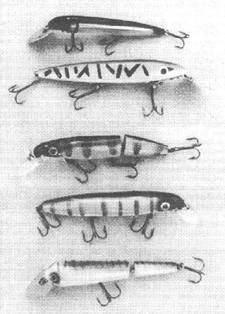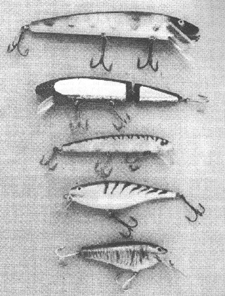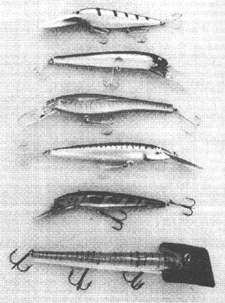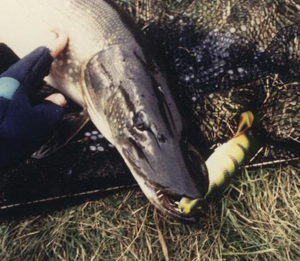[16]
CRANKBAITS AND OTHER PLUGS
There is no doubt that the majority of pike anglers
lure collections comprise mainly of crankbaits.
These are the lures that are often commonly known
as plugs, although this generic term covers just
about any lure that has a large body made of plastic
or wood. So a plug could be a jerkbait, propbait,
chugger or any number of specific lure types.
The term "crankbait" refers to plugs that are
fished, primarily, by casting them out and cranking
them straight back. There is not a lot to say
about fishing crankbaits in this way because they
have enough inbuilt action to attract pike without
any input from the angler, other than to wind
them through the water. This is, after all, how
they are designed to be fished, and what makes
them good trolling lures. Other retrieve patterns
can be used with crankbaits, and these vary from
lure to lure. For example, some can be twitched,
while others refuse to play ball with this retrieve.
A
crankbait's action usually comes from a diving
lip (sometimes called a vane, bill, or wiggle-plate),
which accounts for them sometimes being referred
to as lip-baits. Minnows are lip-baits too,
and although they will work as crankbaits are
often better employed, as I describe elsewhere,
as twitch baits. This is why I have given them
a chapter of their own. Not all crankbaits have
lips, and many that don't are classed as trolling
plugs. This is a grey area of lure classification,
so I have chosen to deal with classic trolling
plugs alongside traditional crankbaits and those
that could be considered to fall somewhere between
the two.
As
with most lures that I use, my preference is
for the larger sizes of crankbait which is a
bit of a problem as the great mass of baits
available are small ones. I am sure that this
is another reason for the widespread view that
lures (plugs in this instance) catch only small
pike. Having said this I am well aware that
small crankbaits will catch large pike from
time to time, my friend Martin McDerby caught
a 34 pounder on a Big S, but I still don't believe
that lures like this are the overall best bet
for bigger pike. I have little to say about
the majority of crankbaits traditionally used
for pike in this country, as, apart from a few
notable exceptions, I reckon they are too small.
When all's said and done, most were originally
intended for the American bass and walleye.
The choice of crankbaits of five inches or longer
is not that great in the U.K. at present, certainly
in the shallower runners, and you will have
to search around or send to America for them.
One or two people are making larger crankbaits
too, but some are better than others and the
quality of finish can leave a lot to be desired.
I have made my own at times and have had some
success with them. If I can make lures that
catch pike, anyone can!
There
are a few factors to be aware of when it comes
to choosing crankbaits, mostly concerning lip
shape and size. Understanding what a particular
lip style does for a lure will save you from
buying baits that don't suit the waters that
you fish. Large lips tend to mean that the lure
will run deep, and the longer the lip the deeper
it will run. Wide lips give the most side-to-side
wiggle, narrow lips a rapid tight wiggle. Bear
in mind, too, that the wider a lip is the greater
its water resistance will be, and therefore,
the harder it will be to crank the lure in.
Fishing lures with lips like this can be physically
demanding to work for long periods - the more
so if the lure is very buoyant and requires
constant cranking to maintain its running depth.
Low stretch line, a slow geared reel and a stiff
rod make fishing lures like this less like hard
work, so bear this in mind too. A few deep divers
are actually weighted towards the front of the
lure, either in its nose or on the lip itself
near the line-tie. Weighting a lure in this
way gives it a tendency to sit nose down in
the water, and causes it to dive more rapidly
and steeply. The angle of the lip has a bearing
on diving depth too. A lip that extends straight
out in front of the plug body will dive deepest,
whereas one that is almost at right angles to
the body will cause the bait to run shallow.
Most deep diving plugs run with the body at
forty-five degrees to the vertical, rather than
just about horizontal like shallow running baits
do. Some lures are available in deep and shallow
running versions, but the actions often vary
tremendously between the two styles. Abu, and
others, produce lures that have adjustable lips.
There is a degree of compromise in this as the
action of the bait alters as you vary the angle
of the lip, this is because the size of the
lip doesn't vary. Even so I have found it quite
a useful feature at times, notably when trolling,
although just a couple of settings seem to work
best. Most metal lipped baits can have their
action altered, and to an extent their running
depth, by bending the lip. Bend lips down for
more wiggle and less depth, and up to achieve
the opposite effect. Going too far in either
direction will almost certainly kill the action
altogether, so take it in stages. Be careful
to bend lips evenly or the lures will track
off to one side. The Creek Chub Pikie is one
lure that can benefit from a bit of lip bending.
Most deep or steep diving crankbaits are easy
to spot as, apart from the large lip, the line
tie is often on the lip rather than the body
of the lure.

Classic crankbaits. Floating diving "plugs"
reaching around four to six feet when cast
and retrieved, with the exception of the adjustable
lipped Hi-Lo. Broom Stick Pikie (home-made
by the author). Creek Chub Pikie (wood). Creek
Chub Pikie (plastic). Lucky Strike Ol' Wooden
Plug (wood!). Abu Hi-Lo. Gudebrod Sniper (plastic
- long discontinued).

Mid to deep diving crankbaits. Note the similarity
of lip angle and shape. The metal lips can
be bent to alter lure action and diving depth.
Husky Cisco Kid (sinker), 6¼" body
length. Super Husky Cisco Kid, 7¾"
body length. Buchertail Jointed DepthRaider.
Solid DepthRaider. Smity Jointed Diver (wood).
Many
crankbaits come in straight and jointed versions.
The straight, single, baits are the most common
and, as far as I am concerned, the most successful.
I realise that my lack of success with jointed
crankbaits is probably due to the little time
I spend using them. In fact, as I think about
now, it I have had more action on jointed lures
than I first thought. I must dig a few out again!
Jointed baits have more action, in terms of
vibration, and some give out more noise as the
body sections knock together. This might just
make them a better bet in coloured water conditions.
Jointed crankbaits are certainly highly rated
for night fishing for muskies in the 'States.
It
is crankbaits that most anglers associate with
rattles. My views on rattles have been expressed
already, and luckily for me few large crankbaits
have them fitted. If anyone had to name the
most famous crankbait for pike it would probably
be the Creek Chub Pikie - and this doesn't rattle.
Case closed! This is undoubtedly a hugely successful
bait, despite its simple shape and lip design,
or maybe because of it. The change from wood
to plastic for lure bodies has had a marked
effect on crankbaits. No one who has used older,
wooden, versions of baits now moulded in plastic
will deny that the wooden lures have much better
actions. It is hard to put your finger on the
the difference, but it is most apparent when
the lures are on the end of your line. Wooden
lures are heavier than their plastic replacements
and therefore cast better too.
Shallow
running crankbaits, down to six or eight feet,
are the most widely used lures in this group.
Perhaps this is because they keep away from
most of the snags and save you pounds in the
process! Shallow divers are pretty simple to
work as the standard steady retrieve catches
well enough. A faster retrieve will get the
bait down quicker and keep it there. At the
other extreme, some baits will work almost on
the surface with a very slow retrieve. Others
will not work at all in this way as they have
a critical retrieve speed. Too fast and they
might burst', flip on to one side or roll right
over. Too slow and they lose all their action.
As a general rule it pays to work crankbaits
as slowly as possible in the coldest conditions,
increasing their speed as the water warms up.
For this reason it is worth having a selection
of lures to cover different diving ranges when
fished at the same speed.
Crankbait
fishing is a much more considered form of lure
fishing than some other searching techniques.
Rather than using cranks to cover a lot of water
to find fish, I prefer to use them in places
where I have either found fish with other baits,
or where past experience has taught me I am
in with a chance of a fish or two. At times
the concentration demanded from crankbait fishing
can be mentally draining. Visualising precisely
what your lure is doing is critical when working
close to features such as weed beds and drop-offs.
Sure, you can just chuck out crankbaits and
wind them back, but I find that a picture in
my mind's eye of the underwater scene gives
me far more confidence - and a higher success
rate. It doesn't really need pointing out that
such an attitude helps with all lures, but search
lures rely far more on a pike reacting instantly
to them than do more slowly fished ones like
crankbaits. I certainly find that when rapidly
searching water I can lower my concentration
level, at least as far as pin-point presentation
goes.
For
dead slow fishing you have to match your lure
to the depth you want to fish. This might entail
using a lure that has a maximum running depth
of twelve feet in a swim that is only four feet
deep. Choose a deep diver that is very buoyant.
The Bagley's Diving Monster Shad is an excellent
choice for this tactic. Having a tight wiggle
and broad, flat sides the Monster Shad can be
retrieved very slowly, but still gives out strong
fish attracting signals of flash and vibration.
Working a lure like this takes patience, because
when I say dead slow I mean as slow as you can
without the lure stalling. It also takes concentration
as the takes from lethargic fish can be very
gentle and need an instant response if you are
to stand any chance of connecting with them.
Why fish shallow water in cold conditions though?
Well you might have no choice, the entire water
might be shallow, but otherwise such areas are
always worth exploring in the months of January
and February when pike start mooching round
their spawning sites. In these days of mild
winters there can still be weed in these spots
at this time of year. A slow cranking retrieve
and a sensitive outfit will enable you to feel
this as soon as the bait touches it. At this
point, or if you feel it dig bottom, pause the
retrieve and allow the lure to float up a foot
or so before starting to crank it again. Takes
are to be expected the instant the lure dives
a little.
In
the deeper weed beds, and in open water during
the summer, a similar technique can be used
- but speeded up. Match the lure to speed and
depth requirements again. Where a Diving Monster
Shad worked in winter you might now need a Grandma,
or another lure with a strong action but a shallow
diving depth, to prevent constant fouling with
the weed which has grown higher in the water.
Drawing the lure forward two or three feet by
moving the rod tip will work the bait quickly
and smoothly. Crank the reel as you return the
rod tip to its initial position, keeping in
touch with the lure all the time. From time
to time you will get takes as the lure floats
up, but these hits are difficult to connect
with. It's a slack line take in effect. Braided
line helps in this situation, because of the
improved feel it gives you of the lure compared
with the use of monofil. Even so, all you might
feel is a knock as the pike grabs, and releases,
the lure. By then it is too late. The steady
retrieve is always a good starting point, but
it is worth breaking it up at times, a sudden
change in action is always likely to trigger
a strike. One fairly subtle way of breaking
up a straight retrieve is to give a few quicker
turns of the reel handle now and then. This
will have two effects on the crankbait. Firstly
it will speed the lure up (you'd never have
guessed, would you?) and it will also make the
lure dive a little deeper with a stronger wiggle.
Making lures behave in an erratic manner is
the best way to trigger pike into taking, so
this increase in action and speed is sometimes
just what is needed to turn a follower into
a taker. A similar effect can be achieved when
trolling crankbaits by either speeding the boat
up every now and then, or if you are holding
the rod by pumping it forwards and dropping
it back. Again a change in lure action can trigger
strikes. This is one of the most important things
to remember about working your lures, and is
as close to a hard and fast rule as you are
likely to find in this book. Many crankbaits
can be twitched, a little like minnow baits.
The technique is much the same but the resulting
action is quite different. I find the best crankbaits
for twitching are actually the deeper divers,
with broad lips. Baits like Pikies and Hi-Los
haven't worked too well for me when twitched,
being more suited to the quick-slow-quick type
of retrieve, but Diving Monster Shads and straight
DepthRaiders are another matter. Both are pretty
buoyant lures which means that they can be twitched
slowly in shallow water, despite the fact that
they will run deep. Maybe it is the flatish
bodies that make these particular lures good
for twitching, but more likely the wide lips.
Because the lures try to dive steeply they can
be kept in one spot for a number of twitches,
bobbing back to the surface almost exactly where
they were twitched from. Both these baits can
be made to turn through ninety degrees when
fished like this. If you have pinpointed a pike
holding spot, it is well worth casting a crankbait
well past it and retrieving it steadily. As
the lure gets in line with where you think a
pike should be lying start twitching the bait.
Not too violently, but in a subtle sort of way.
Many's the time a pike has shot out and grabbed
a lure of mine worked like this, from under
floating rafts of weed and from gaps in reed
beds. I think the waiting pike will have become
aware of the lure well in advance of its arrival,
and the sudden change in its action, right next
to the fish, triggers it in a way it can't resist.

Flat-sided crankbaits. Although the Grandma
can also be considered as a minnow bait, its
flat sides give it shared characteristics
with the shad-type lures - notably flash,
and wiggle. All are superb twitch baits but
troll well too. Magna Strike Grandma, 9".
Grandma, 7½" jointed. Grandma, 6".
Rapala Super Shad Rap, 14cm. Bagley Diving
Monster Shad, 4 ".
Another
excellent crankbait for twitching is the relatively
new Super Shad Rap from Rapala. Already the
general opinion is that this bait is destined
to become a classic. With a lovely wiggle on
a straight crank, and diving to around five
feet, it offers a nice bold profile to the pike
with its flat shad shape. Twitching this bait
really does make it something special as I found
one January day. I had been using my usual dead-slow
winter cranking retrieve, it has worked so often
in cold water that it is my first line of attack.
On this occasion, however, my slow cranked Grandma
had only produced one tiny pike. Partly out
of boredom, and partly out of frustration, I
started twitching the lure. Literally on the
first cast using this change of tactics a decent
pike came up behind the bait, only to turn away
at my feet. The fish was easily recognisable
owing to a red mark on one flank. A few more
casts produced nothing so I switched to a Super
Shad Rap and began twitching that. In short
time a fish took it gently, but threw the bait
when it thrashed its head on the surface. I
obviously hadn't driven the hooks home, and
the way the pike came straight to the surface
made it difficult to rectify the situation.
A few more casts and something hammered the
bait, this time it stayed hooked and turned
out to be the fish that had followed the Grandma
in. A nice mid-double. Even in winter it pays
to keep on twitching. I have found that the
Super Shad Rap is a poor hooker as have a number
of anglers I have spoken to. Others, though,
have had no problems. If you suffer the same
difficulty as me with this lure switch the hooks
to a larger size, 3/0 seems about right. Using
a finer wire hook for the replacements also
gives the bait a bit more wiggle on a straight
retrieve, and flash on the twitch.
For
fishing close to the bottom where it is rocky
or stony it is best to go for a certain lip
type of diving bait. The ones to look for are
deep runners that have a long lip coming out
almost horizontally from the body with the line
tie mid-way along the lip. These baits tend
to run with their body at forty-five degrees
which keeps the hooks away from snags, and when
the lip hits bottom the angle of pull from the
line flips the lure vertical and clear of the
obstruction. Should one of these lures wedge
behind a rock feed some slack, and it will usually
float out the way it went in. Baits like this
that spring to mind are the Ryobi Deep Dixie,
Storm Big Mac and Bagley's less buoyant Diving
Bang-O-B series (known colloquially by their
code numbers as the DBO6 and DBO8). Like the
shallow running Big Dixie, the Deep Dixie is
not actually made by Ryobi, and I have seen
it listed by at least two other companies under
other names! This doesn't stop it being a good
lure though. Many lip baits like these can also
be fished through sparse weed without hanging
up too much. As they have fairly tight wiggles
the hooks stay behind the bait, and away from
from the weed.
Kwikfish
behave pretty much the same when confronted
with rocks, but are less good in weed as they
have a much wider wiggle. Originally intended
as trolling plugs Kwikfish, and the almost identical
Helin's Flatfish (now marketed as the Worden's
FlatFish by the Yakima Bait Co.), work quite
well on a straight retrieve, but are difficult
to cast without fouling the trace - no matter
what anyone says. The larger sizes are very
buoyant while the smaller ones sink. I find
most use for are the larger one-piece floaters
which I like to twitch on and just under the
surface. The jointed models I reckon work best
on a straight retrieve - the slower the better
in most instances - or on a quick/slow/quick
retrieve. It is difficult to bring these lures
back too quickly in the larger sizes owing to
the resistance they put up to your efforts to
crank them in. It will come as no surprise that
both Kwikfish and Flatfish are good trolling
lures! Because of their broad banana shape these
baits are not good for hooking pike. Some of
the Flatfish models have dual treble hooks on
spreader wires for this very reason, but this
is a veritable weed magnet. Adding an extra
split ring to the belly hook, placing it further
from the body, helps to an extent.

Deep diving crankbaits. Most of these baits
share a slim body shape, and it is worth comparing
the lip shapes and line-tie positions. Storm
Big Mac. Ryobi Deep Dixie (this lure is also
marketed under other names by various firms).
Bagley DBO8. Rapala Magnum (sinker). Yozuri
L-Jack Minnow (sinker). Smity Large Troller
(wood), 8½" body length.
Another
trolling plug that gets used as a crankbait
is one that, like the Kwikfish/Flatfish family,
comes under two names from two manufacturers
but which are just about identical - the Believer
or Swim Whizz. The only discernable variation
is the shape of the 'tail' of the lures, that
and the name on the side of them. Like the Kwikfish
these, too, are poor casters - no matter what
anyone says. Better on multiplier outfits where
the reel acts as a brake on the lure, but still
liable to tumbling and tangling with the trace
at times. Their hooks are also prone to tangle
with each other, and to foul the body from time
to time too. The Swim Whizz and Believer have
two line ties - the upper one gives the deepest
running depth, and the lower one the shallowest.
The largest sizes (8" plus) are very buoyant
and can be twitched in the surface layers on
the shallow setting (front line-tie). They work
a little like a jerkbait as they have some degree
of swing, far more than most crankbaits or minnows.
A long, stroking sweep of the rod is what I
find works best with this lure after first cranking
it down a couple of turns. Sharp jerks can cause
it to 'burst' and flop on the surface. As straightforward
crankbaits, using the deeper setting, I haven't
had much success with this bait, although I
know a number of anglers who have. Another case
of lack of effort I guess.
As
with so many hollow bodied lures that come in
a range of sizes, the bigger Swim Whizzes have
a greater inherent buoyancy than the smaller
ones. The same applies to the excellent Magna
Strike Predator and Equalizers. So good are
these lures that I don't know of anyone who
has used these two lures and not caught pike.
There is something about Magna Strike baits
that pike seem to find irresistible. Both these
lures are one piece lipless crankbaits, getting
their wiggle and dive from the shape of their
heads. I suppose the Equalizer does have a lip
really, but it is an integral part of the lure,
along with a bracing section behind it. The
Predator is the shallowest runner of the two,
the six inch model diving only a couple of feet
when cast. In the right situation it can be
absolutely deadly cranked back at high speed,
as fast as you can without your wrist giving
way. This tactic works best in pike packed shallow
water with plenty of weed close to the bottom.
Say four or five feet of clear water, with two
to three feet of weed. The pike need to be active,
so it is best if the water is relatively warm.
Spring, before the weed gets too dense, or a
warm spell in autumn after the weed has begun
to die back a little. I found a situation where
this was the tactic required to get a take,
and used the Predator, Gudebrod Maverick and
large willow leafed spinnerbaits to fish shallow
and fast enough to get a response - I had about
a dozen takes in an hour, seven of them to a
six inch Predator. The Predator can also be
twitched, when it works rather like a fat minnow
bait, on and just below the surface.
The
seven inch Equalizer weighs 3oz (provided the
weight has been put in when it was made) and
dives quite quickly to eight feet or a little
more. This one, too, can be twitched, working
correspondingly deeper than does the Predator.
It also casts like a bullet, provided you have
a rod capable of throwing it, and so makes a
good choice for casting into strong winds and
reaching far out into big stillwaters. I have
an Equalizer that for some reason has no added
weight, and this prized possession runs somewhere
between the standard model and the Predator.
Unfortunately Magna Strike lures are noted for
suffering from a leak problem. The Grandmas
are not too bad, for some reason, but the others
frequently take on water. They are not without
other production defects either, I have had
a lip fall out of a Grandma and have heard of
them snapping off too. A pity that quality control
is so bad as they are not cheap lures, and they
work really well. So well that even the less
than brilliant paintwork doesn't bother the
pike. I have heard people say that they wouldn't
buy these lures because of the finish. Well,
they are missing out on some great sport. If
the main thing that interests you about a lure
is what it looks like when it comes out of the
box, then you have got your priorities wrong.
It is what it does in the water that matters.
I
mentioned DepthRaiders earlier, and these crankbaits
are little known in the U.K. This is largely
down to their unavailability in the U.K. until
very recently and their price, which puts a
lot of people off being fairly high even in
the 'States. Like the Magna Strikes they are
worth taking some trouble to get hold of though,
but these lures are tough and the finishes superb.
Unlike the bulk of six inch crankbaits (the
DepthRaider is listed as eight inches which
this includes the lip - the body actually measures
6 inches), Creek Chub Pikies and so forth, DepthRaiders
dive that bit deeper. Whereas most of the afore-mentioned
baits run to six or eight feet when cast, DepthRaiders
get down to ten feet or so. This gives you an
added variation when conditions dictate, allowing
you to fish deeper at the same speed, or slower
at the same depth. On one occasion I had moved
into a new and deeper swim, this was after catching
a few fish shallow on Predators cast close to
the reeds. I was boat fishing and my partner
and I decided that in this spot we should switch
to deeper running crankbaits after I'd caught
a fish on a float legered deadbait, having initially
tried the shallow lures. I switched to a straight
DepthRaider and picked up a fish almost straight
away. Another choice might have been the Bagley's
DBO6 which Geoff swapped to and also caught
on.

What lovely teeth you have. A Magna Strike
Equalizer accounted for this mean looking
fish, one that clearly illustrates the need
for a wire trace when lure fishing for pike.



